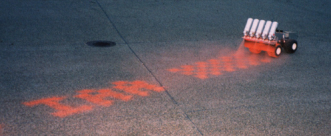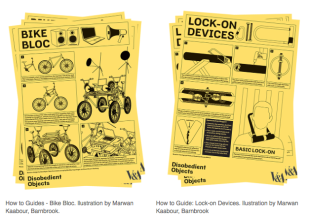Disobedient Objects is an exhibition dedicated to the items utilized in revolutionary practices. It highlights the importance that objects have when social and political development is a necessity in the public’s eyes, and how inventive people become when action has to be taken.
It has been divided into sections, showing the different strategies used to achieve change – making words, speaking out, solidarity, and direct action.
A variety of pieces feature in the show, from an impressive mosaic truck devoted to celebrating the day of death, to your stereotypical hand held signs used in the majority of demonstrations.
What I found astonishing though, (in an impressive, yet shocked way), was the pure creativity rioters took to when designing objects for protesting. The ‘graffiti-writing robot’ is an example, which was designed to spread messages using spray paint. Maneuvered via remote control, the user would be able to broadcast political views without the worry of being caught by the police.
Rioting and rebellion is at the core of this exhibition, providing a strong message that anyone, anywhere can protest, with most of the items displayed being everyday or handmade objects. From this, however, I got the idea that if you are passionate about making a change, then you need to be willing to suffer the consequences. I say this after having seen one of the films describing a very successful tool used in riots, called ‘lock-ons’.
Lock-ons are long metal tubes with a central bolt-esque pole inside, with which protestors can attach their arms using handcuffs, one on either side of the bolt. This really was an innovative piece of equipment, designed by Australians in the late 80s. I found this video particularly interesting, revealing the development of the lock-on as technology advanced. The police managed to build an instrument to cut through the tubes, which would stop when it came close to contacting the arms. This meant that the protestors had to come up an innovative way of preventing the use of instrument, which they managed to do. By confusing it’s forewarning mechanism, using items such as chicken wire and so on, the radar wouldn’t work, and so the police’s efforts were futile.
It’s a little gruesome thinking about this, as I start to question how on earth did the police figure this out before it was too late? The term ‘no pain no gain’ comes to mind… Moreover, seeing as the lock-on protesters would have to sit around without the use of their arms for hours on end, how would they function? Surely eating and drinking is out of the window, but what about the necessities, like use a toilet? An interview with a lady who has taken part in this kind of protesting described it as exhausting, and it isn’t hard to imagine why when the clips are shown.
Whilst wondering around the exhibition, it was interesting to notice there was a trend following the objects presented. The majority of the items have been designed and created by left-wing protest groups. Gavin Grindon, one of the curators of the exhibition, elaborates;
“I think, by structure, those movements on the far-right aren’t about creating solidarity, aren’t about creating new worlds. They’re often about preserving at least imagined versions of the world, so they tend [to] not radically experiment with the culture.” He says, “They tend not to have the same level of creativity.” (Nico Hines, 2014)
Admittedly, I don’t agree with this last comment. It seems unfair just to say ‘all right wing followers lack creativity’, and generalize a group in that way. (It appears that I am not the only one as well after reading a couple of the comments on the article. Find the amusing read here).
What really inspired me were the portrait postcards (We Are Not Numbers Postcards and Posters), related to the Mortgage Crisis in Spain, 2013. They were a second thought, after the portraits of the mortgage debt victims were originally used to façade the banks responsible for the crisis. Only later on were postcards sent directly to the banks, comprised of the victims’ portraits and accompanying stories. Feeling as though they needed to speak louder, the postcards were then sent to the politicians, as a last resort, whilst the ‘escrache protests’ were taking place. I like this idea of getting your message out there using an object so simple, yet very able at getting an opinion across.
I actually visited this exhibition twice, but although the exhibition items were exactly the same and all in the same places, the atmosphere of the area was completely different. The first time I went was for an event, so naturally the exhibition was packed and there was the buzz of conversation. The second time I visited however, was just a regular Wednesday, meaning a quite day at the V&A compared to an event. It was far more eerie and therefore I got a real feel for the exhibition. There was also some music devoted to the exhibition, played out via a machine called a ‘bike bloc’, which can be made and used to protest public spaces with ease. The music consisted of the sounds of some of the items featured, and some footage from real protests, making you feel involved in the movement and feel the fear and electricity of the whole event. Have a listen to the track here.
An really intriguing exhibition and definitely worthwhile. Check it out!








